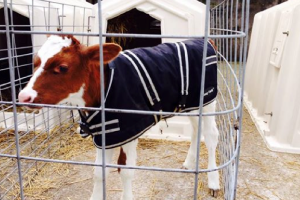Having reared calves on and off for 15 years or more I have first-hand experience of the problems faced keeping calves healthy during the first few weeks of life. I think the average losses of calves is put at around 14% including stillborn and death due to hard calving, nevertheless the losses due to infections, scours and pneumonia account for a great percentage of the average.
 We are not all in a position of having draught free, temperature controlled buildings in which to rear our calves. Many of us rear the calves in older more traditional farm buildings as these are not suitable for the older stock. Older style buildings are often draughty unless maintenance is high on your list of priorities! More importantly though these buildings do not have the best ventilation therefore calves are more prone to pneumonia.
We are not all in a position of having draught free, temperature controlled buildings in which to rear our calves. Many of us rear the calves in older more traditional farm buildings as these are not suitable for the older stock. Older style buildings are often draughty unless maintenance is high on your list of priorities! More importantly though these buildings do not have the best ventilation therefore calves are more prone to pneumonia.
 The other extreme is to rear calves in large open plan buildings with high rooves, which are easy to access with large farm equipment. Unfortunately in our climate these buildings often subject the calves to massive temperature changes in a matter of a few hours, easily a drop of 12 degrees C between day and night.
The other extreme is to rear calves in large open plan buildings with high rooves, which are easy to access with large farm equipment. Unfortunately in our climate these buildings often subject the calves to massive temperature changes in a matter of a few hours, easily a drop of 12 degrees C between day and night.
I have experienced both styles of buildings and tried to adapt each to find the best conditions to rear healthy calves. The biggest problems are how to keep the calves at a comfortable and regular body temperature without restricting airflow or increasing humidity and how to get enough milk/feed into them to keep them growing in cold weather without giving them scours.

I recently read some articles on calf rearing abroad and could not believe how many farms in cold weather, used calf jackets/coats as a matter of routine to, improve conversion of energy to growth and therefore reduce feed costs, to reduce the risk of pneumonia and scours from chills and therefore reduce medication costs and calf mortality.
Having attended a number of veterinary courses on calf rearing it has become obvious that many of our breeds today and the time of year we calve our cows, calves really struggle with, firstly the cold temperatures and secondly the dramatic change in temperatures from day to night or even day to day, especially during the first four weeks of life.
